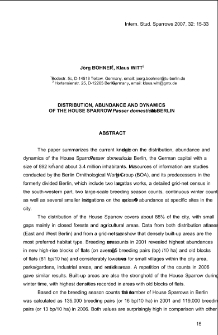Digital Library of Zielona Góra contains 63 482 digital objects
Object
Title: Distribution, abundance and dynamics of the House Sparrow "Passer domesticus" in Berlin
Group publication title:
Abstract:
The paper summarizes the current knowledge on the distribution, abundance and dynamics of the House Sparrow "Passer domesticus" in Berlin, the German capital with a size of 892 km2 and about 3.4 million inhabitants. Main sources of information are studies conducted by the Berlin Ornithological Working Group (BOA), and its predecessors in the formerly divided Berlin, which include two large atlas works, a detailed grid-net census in the south-western part, two large-scale breeding season counts, continuous winter counts, as well as several smaller investigations on the species` abundance at specific sites in the city. ; The distribution of the House Sparrow covers about 88% of the city, with small gaps mainly in closed forests and agricultural areas. Data from both distribution atlases (East and West Berlin) and from a grid-net census show that densely built-up areas are the most preferred habitat type. Breeding season counts in 2001 revealed highest abundances in new high-rise blocks of flats (on average 95 breeding pairs (bp) /10 ha) and old blocks of flats (81 bp/10 ha) and considerably lower values for small villages within the city area, parks/gardens, industrial areas, and residential areas. ; A repetition of the counts in 2006 gave similar results. Built-up areas are also the stronghold of the House Sparrow during winter time, with highest densities recorded in areas with old blocks of flats. Based on the breeding season counts the total number of House Sparrows in Berlin was calculated as 135,000 breeding pairs (or 16 bp/10 ha) in 2001 and 119,000 breeding pairs (or 13 bp/10 ha) in 2006. Both values are surprisingly high in comparison with other large European cities. The difference between 2001 and 2006 is considered as normal fluctuation and not a decline, a view supported by the annual winter counts conducted during that period. ; Furthermore, the long-term winter data since 1993/94 as well as an estimate for the entire population at the beginning of the 1990s (100,000 to 200,000 bp) strongly indicate stable numbers of House Sparrows in Berlin for at least the last 15 to 20 years. ; It is not clear why Berlin differs so much from cities such as Hamburg, London, and Warsaw, where considerably lower numbers of House Sparrows were found and where the species has been declining more or less strongly in the recent past. Food (natural and anthropogenic) and nesting sites (especially crevices and cavities at buildings) are still abundant in Berlin, while recent studies show a sufficiently high reproductive success of the species also.
Publisher:
Zielona Góra: University of Zielona Góra, Faculty of Biological Sciences
Format:
Resource Identifier:
Pages:
Source:
International Studies on Sparrows, vol. 32
Language:
Rights:
Biblioteka Uniwersytetu Zielonogórskiego
Object collections:
- Digital Library of Zielona Góra > Repository > Faculties > Faculty of Biological Sciences
- Digital Library of Zielona Góra > Repository > Types of work > Articles
- Digital Library of Zielona Góra > Repository > Scientific journals and UZ publishing series > International Studies on Sparrows
Last modified:
May 23, 2023
In our library since:
May 4, 2023
Number of object content hits:
255
All available object's versions:
https://zbc.uz.zgora.pl/publication/81543
Show description in RDF format:
Show description in OAI-PMH format:
| Edition name | Date |
|---|---|
| Distribution, abundance and dynamics of the House Sparrow "Passer domesticus" in Berlin | May 23, 2023 |
Objects Similar
Laet, Jenny De Summers-Smith, Denis J. Mallord, John
Dilip Clinton, Samson Arockianathan Ramakrishnan, Balasundaram Samson, Arockianathan Karthick, Sivaraj Girikaran, Prabakaran Deepan, Ravi
Gokulakrishnan, G. Sivaperuman, C. Narayana, B. Laxmi
Jędro, Grzegorz Jędro, Magdalena
Zawadzki, Grzegorz Jackowiak, Mateusz Zawadzka, Dorota

